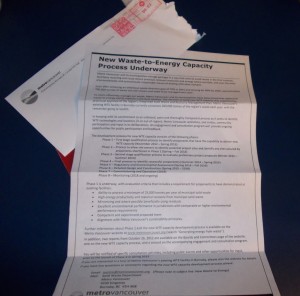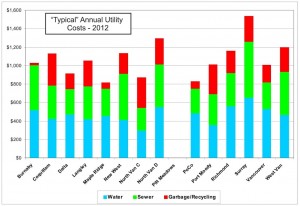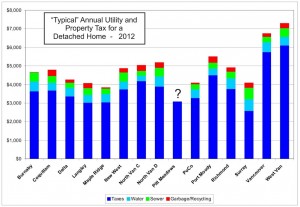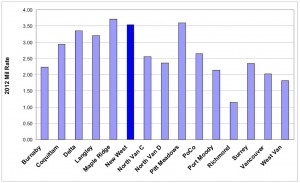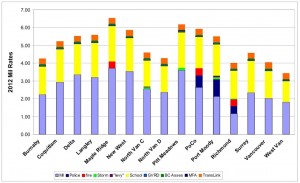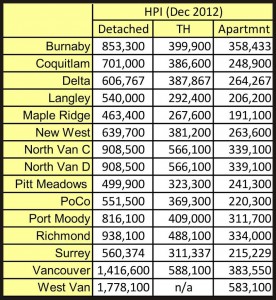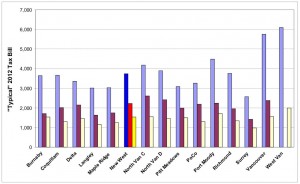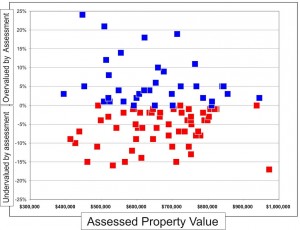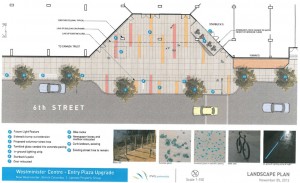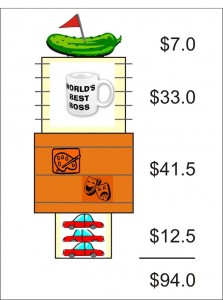The expansion of Waste-to-Energy plants is creeping back into the news again, and people in New Westminster had better pay attention. I almost forgot all about it, but yesterday I got a letter in the mail from MetroVancouver telling me about the ongoing selection process for new garbage burners:
This is probably because I was involved actively in the long drawn-out public engagement process for Metro Vancouver’s Integrated Solid Waste Resource Management Plan, where the public across the region were vocally opposed to increased trash incineration. MetroVancouver nonetheless barged ahead, and got the plan through the Minister of Environment with waste-to-energy a major component in the plan.
Notably, it took a change in Provincial Ministers of Environment to get it through. The folks in the Fraser Valley are strongly opposed to those of us upwind burning our trash and dumping the air pollution into their air quality index, and the ever-awesome Barry Penner couldn’t sign off on the plan for fear of pitchforks at his Chilliwack office. So when Terry Lake (who, as best I can tell, is a smart, well considered guy – one of the few very bright lights in the current BC Liberal caucus) took over the Environment file, he was far enough removed from the Valley to sign it off.
During the earlier consultations, and pretty much ever since whenever anyone is unwise enough to ask me, I have made my position on Trash Incinerators very clear: they are an unsustainable way to manage solid waste, and an unsustainable way to generate electricity. Importing hydrocarbons from China to burn for electricity is no different if those hydrocarbons are in the form of coal or in the form of plastic bits that happened to have travelled through a WalMart before we burn them. The atmosphere can’t see the difference: fossil carbon is fossil carbon. This shouldn’t be a NIMBY issue- I don’t want a trash incinerator in New Westminster, and I don’t want one in Surrey, or Langley or Gold River.
However, not all WTE plants are trash incinerators. There is one operation currently ramping up just across the river in Richmond that is a better example of how we can more sustainably manage a large portion of our waste stream. The system is just starting to come on-stream, but represents what is (in my opinion) a much more sustainable path for WTE.
Harvest Power takes the organic wastes that people across the Lower Mainland put into our curb-side “green bins”, plus a fair amount of commercial food waste, and turns it into electrical power. This is a multi-step process:
- Organic wastes are ground up to reduce size of the stinky bits;
- The resultant muck is placed in percolator cells, where warm water is dripped through in a low-oxygen setting, drawing a hydrocarbon-rich “tea” out the bottom;
- After about 10 days, the volume of solids in the percolator cells are significantly reduced and the decomposition slows right down, so these solids can be mixed with woody waste and sand to make a rich organic compost for farms, gardens, municipal lands;.
- The “tea” is directed to digester vessels, where specialized bacteria is used to further decompose the tea of longer-chain hydrocarbons down to methane;
- The methane can then be burned to spin a turbine and create electricity;
- The resultant by-products are the biosolids in the compost, CO2 from the burnt methane, and water vapour.
There are several ways this differs from the Burnaby Trash Incinerator. The most significant difference is that the carbon going into the system is biospheric carbon- that is carbon that has been very recently removed from the atmosphere and trapped in organic compounds by plants, and not fossil carbon. So no plastics or fossil carbon are going through this process. The CO2 emissions are 100% non-fossil fuel.
A second bonus of this process is that it relies on the separation of plastics from organics. This should be the first goal of any modern Solid Waste plan, because plastics are generally recyclable unless they are too contaminated with organics. Even for the plastics we cannot recycle, landfilling is much more sustainable and safe if the putrescible wastes and liquids are removed before burying the wastes. Dry, clean plastic going into a landfill will remain stable for centuries- it won’t leach metals, it won’t generate methane or nasty volatiles, it actually represents the only proven, demonstrable, and practical form of long-term carbon sequestration that engineering has yet provided to us.
However, to make landfills effective carbon sinks, we need to get the greasy, wet, “stinky” organics out of the landfill. They make the landfill less sustainable, and cause otherwise stable plastics to break down into less inert materials. That there are better things to be done with organics that do not involve the unsustainable burning of fossil fuels is really just a bonus.
Unfortunately, much of the discussion of waste-to-energy that Metro is running these days is less public than the Integrated Solid Waste Resource Management Plan was (despite the letter I got in the mail). The media reports are also unclear, as demonstrated in these two quotes came from the same story I linked to above:
“Ross said a key question is whether a new incinerator is built in Metro Vancouver or at an out-of-region site.”
…and…
“Meanwhile, Metro is currently calling for prospective partners to table their credentials and what type of waste-to-energy technology they’d use.”
So is the debate currently only “location of an incinerator”, or are other technologies aside from incinerators being considered?
I sure hope it is the latter, because that will make the difference whether many of us will support WTE in our community, or even the idea of shipping our waste to other communities to be made into energy.
